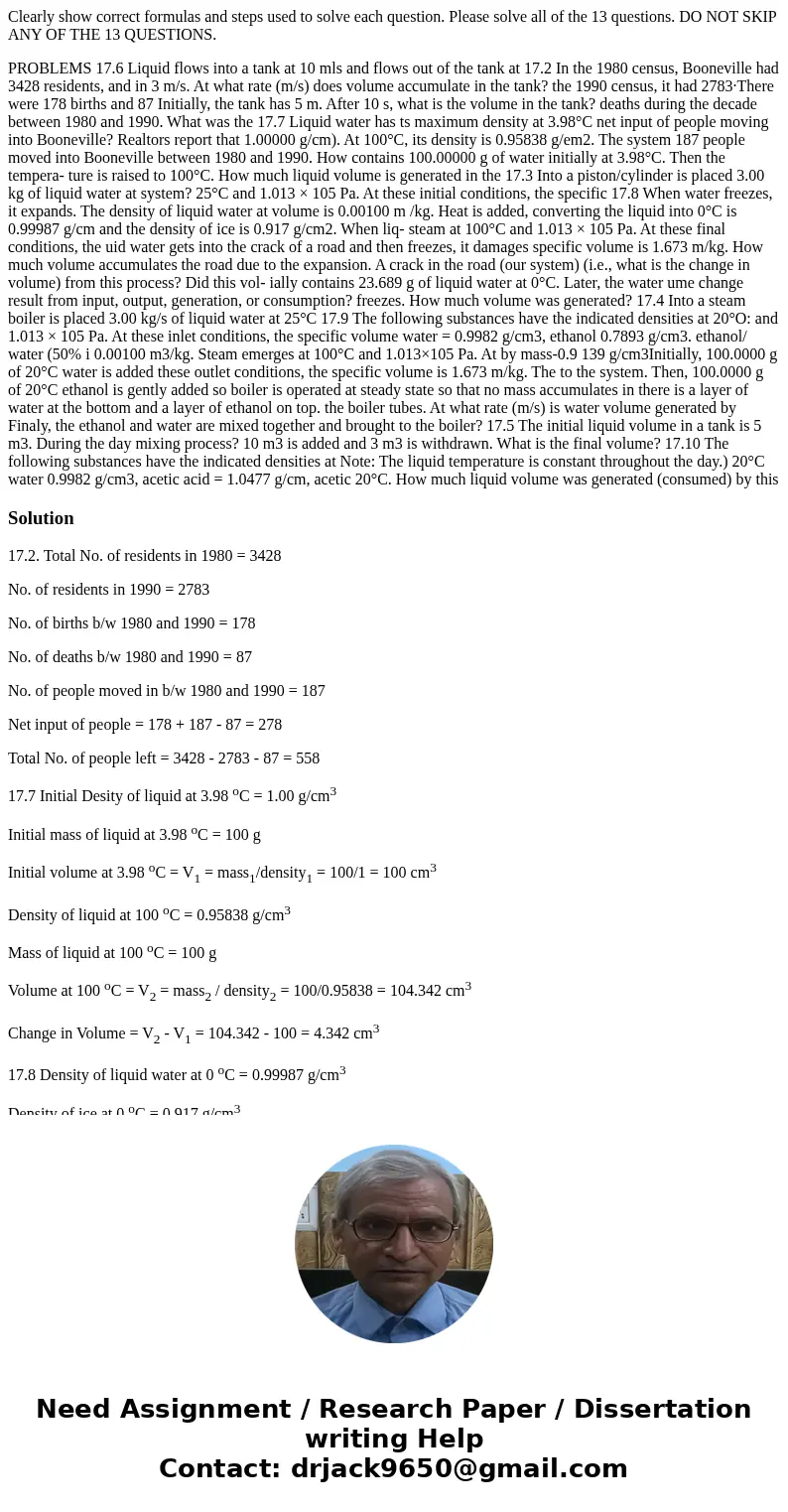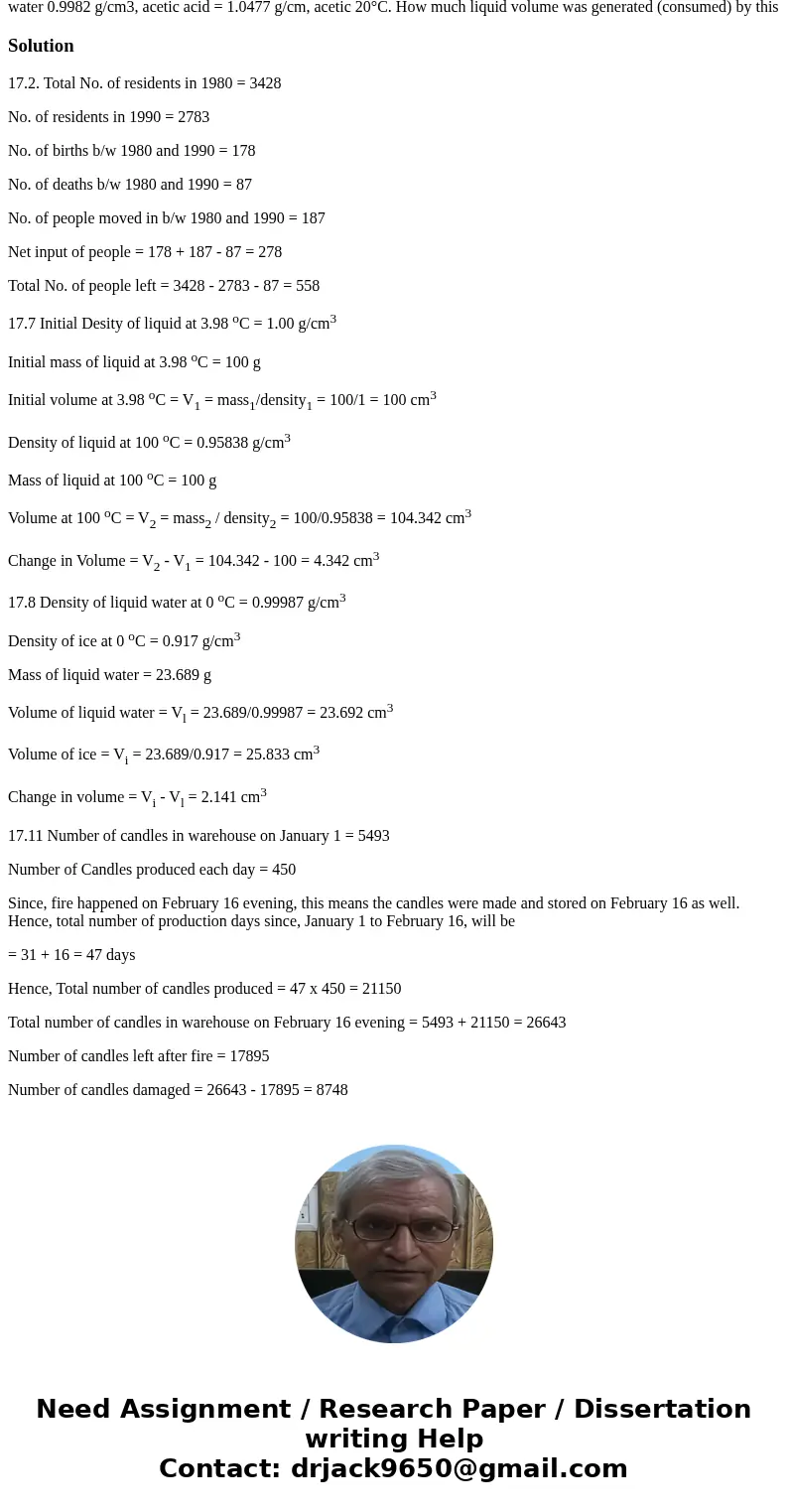Clearly show correct formulas and steps used to solve each q
Clearly show correct formulas and steps used to solve each question. Please solve all of the 13 questions. DO NOT SKIP ANY OF THE 13 QUESTIONS.
PROBLEMS 17.6 Liquid flows into a tank at 10 mls and flows out of the tank at 17.2 In the 1980 census, Booneville had 3428 residents, and in 3 m/s. At what rate (m/s) does volume accumulate in the tank? the 1990 census, it had 2783·There were 178 births and 87 Initially, the tank has 5 m. After 10 s, what is the volume in the tank? deaths during the decade between 1980 and 1990. What was the 17.7 Liquid water has ts maximum density at 3.98°C net input of people moving into Booneville? Realtors report that 1.00000 g/cm). At 100°C, its density is 0.95838 g/em2. The system 187 people moved into Booneville between 1980 and 1990. How contains 100.00000 g of water initially at 3.98°C. Then the tempera- ture is raised to 100°C. How much liquid volume is generated in the 17.3 Into a piston/cylinder is placed 3.00 kg of liquid water at system? 25°C and 1.013 × 105 Pa. At these initial conditions, the specific 17.8 When water freezes, it expands. The density of liquid water at volume is 0.00100 m /kg. Heat is added, converting the liquid into 0°C is 0.99987 g/cm and the density of ice is 0.917 g/cm2. When liq- steam at 100°C and 1.013 × 105 Pa. At these final conditions, the uid water gets into the crack of a road and then freezes, it damages specific volume is 1.673 m/kg. How much volume accumulates the road due to the expansion. A crack in the road (our system) (i.e., what is the change in volume) from this process? Did this vol- ially contains 23.689 g of liquid water at 0°C. Later, the water ume change result from input, output, generation, or consumption? freezes. How much volume was generated? 17.4 Into a steam boiler is placed 3.00 kg/s of liquid water at 25°C 17.9 The following substances have the indicated densities at 20°O: and 1.013 × 105 Pa. At these inlet conditions, the specific volume water = 0.9982 g/cm3, ethanol 0.7893 g/cm3. ethanol/ water (50% i 0.00100 m3/kg. Steam emerges at 100°C and 1.013×105 Pa. At by mass-0.9 139 g/cm3Initially, 100.0000 g of 20°C water is added these outlet conditions, the specific volume is 1.673 m/kg. The to the system. Then, 100.0000 g of 20°C ethanol is gently added so boiler is operated at steady state so that no mass accumulates in there is a layer of water at the bottom and a layer of ethanol on top. the boiler tubes. At what rate (m/s) is water volume generated by Finaly, the ethanol and water are mixed together and brought to the boiler? 17.5 The initial liquid volume in a tank is 5 m3. During the day mixing process? 10 m3 is added and 3 m3 is withdrawn. What is the final volume? 17.10 The following substances have the indicated densities at Note: The liquid temperature is constant throughout the day.) 20°C water 0.9982 g/cm3, acetic acid = 1.0477 g/cm, acetic 20°C. How much liquid volume was generated (consumed) by thisSolution
17.2. Total No. of residents in 1980 = 3428
No. of residents in 1990 = 2783
No. of births b/w 1980 and 1990 = 178
No. of deaths b/w 1980 and 1990 = 87
No. of people moved in b/w 1980 and 1990 = 187
Net input of people = 178 + 187 - 87 = 278
Total No. of people left = 3428 - 2783 - 87 = 558
17.7 Initial Desity of liquid at 3.98 oC = 1.00 g/cm3
Initial mass of liquid at 3.98 oC = 100 g
Initial volume at 3.98 oC = V1 = mass1/density1 = 100/1 = 100 cm3
Density of liquid at 100 oC = 0.95838 g/cm3
Mass of liquid at 100 oC = 100 g
Volume at 100 oC = V2 = mass2 / density2 = 100/0.95838 = 104.342 cm3
Change in Volume = V2 - V1 = 104.342 - 100 = 4.342 cm3
17.8 Density of liquid water at 0 oC = 0.99987 g/cm3
Density of ice at 0 oC = 0.917 g/cm3
Mass of liquid water = 23.689 g
Volume of liquid water = Vl = 23.689/0.99987 = 23.692 cm3
Volume of ice = Vi = 23.689/0.917 = 25.833 cm3
Change in volume = Vi - Vl = 2.141 cm3
17.11 Number of candles in warehouse on January 1 = 5493
Number of Candles produced each day = 450
Since, fire happened on February 16 evening, this means the candles were made and stored on February 16 as well. Hence, total number of production days since, January 1 to February 16, will be
= 31 + 16 = 47 days
Hence, Total number of candles produced = 47 x 450 = 21150
Total number of candles in warehouse on February 16 evening = 5493 + 21150 = 26643
Number of candles left after fire = 17895
Number of candles damaged = 26643 - 17895 = 8748


 Homework Sourse
Homework Sourse